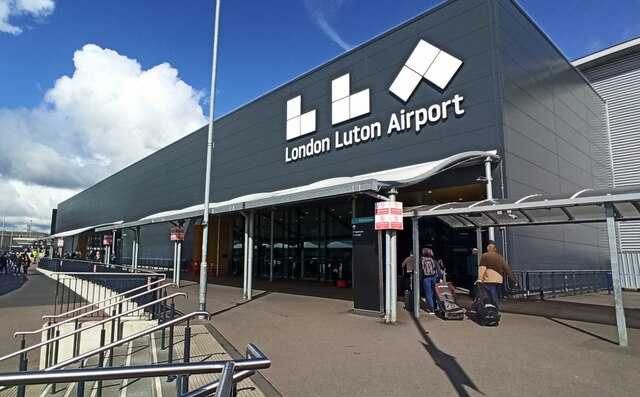On 10th October 2023 there was a fire broke out in one of the car parks at Luton Airport which causes significant disruption, damage, and concerns over safety. The blaze, which resulted in the destruction of hundreds of vehicles and temporarily closed parts of the airport that made headlines across the UK.
How Did the Luton Airport Fire Start?
The fire started in the multi-storey Terminal Car Park 2 at Luton Airport. Initial reports suggest that the blaze may have been triggered by an electrical fault in one of the vehicles parked on the upper levels of the structure. The fire quickly spread due to the close proximity of other vehicles and the presence of flammable materials such as petrol, diesel, and car batteries.
Eyewitnesses described scenes of chaos as thick black smoke billowed across the airport grounds. Emergency services responded rapidly, but the fire spread quickly, resulting in the destruction of nearly 1,500 vehicles, according to the latest estimates. Despite their best efforts, firefighters were unable to contain the blaze before it inflicted extensive damage on the car park and the surrounding area.
The Scale of the Damage
The extent of the damage caused by the fire at Luton Airport is considerable. The multi-storey car park, which could accommodate over 1,200 vehicles, suffered structural collapse in some areas. Several floors of the car park were left unstable, and the heat from the fire melted metal, destroyed concrete, and shattered windows. The fire destroyed hundreds of vehicles, leaving many travellers and airport staff dealing with the loss of their personal belongings.
Authorities estimate that over 100 firefighters were involved in controlling the blaze, which took more than 12 hours to fully extinguish. While there were no fatalities, several firefighters and members of the public required medical attention for smoke inhalation. The scale of the fire led to widespread concern among passengers, airport employees, and local residents.
Impact on Airport Operations
The fire caused a significant disruption to Luton Airport’s operations. As the fire occurred in one of the main car parks near the terminal, emergency services had to restrict access to large parts of the airport. Flights were grounded, and those arriving at Luton Airport faced significant delays. The airport management had to shut down both inbound and outbound flights for several hours due to safety concerns and the smoke affecting visibility around the terminal.
In addition to flight cancellations, access to Luton Airport by road was heavily restricted. Many travellers found themselves stranded at the airport, unable to retrieve their vehicles from the car park or reach alternative transport options. The disruption extended into the following days, with many car park customers left wondering when they would be able to retrieve their vehicles, if at all.
The fire prompted airport management to coordinate closely with airlines, local transport authorities, and the emergency services to restore normal operations as quickly as possible. However, the car park remained closed for investigation and assessment, leading to continued challenges for passengers.
The Investigation: What Went Wrong?
In the immediate aftermath of the fire, authorities launched a thorough investigation to determine the exact cause and any possible negligence. Initial reports pointed to a vehicle fault, but investigators looked into whether the car park’s infrastructure played a role in the fire’s rapid spread. Questions arose about the car park’s design, particularly in relation to its ability to contain fires and prevent the spread between vehicles.
Car parks are typically designed to handle smaller vehicle fires, but the intensity of the blaze at Luton Airport raised concerns about fire safety measures in multi-storey car parks, particularly those adjacent to critical infrastructure like airports. Fire prevention systems, including alarms, sprinklers, and fire-resistant materials, are likely to come under scrutiny as part of the ongoing investigation.
The Response from Luton Airport
Luton Airport’s management has expressed its deep regret over the incident and emphasised the safety and well-being of passengers and staff as their top priority. The airport quickly set up assistance centres for affected passengers, providing help with flight rebooking, transport alternatives, and accommodation.
Airport authorities also worked closely with local car insurance providers to help customers file claims for vehicles destroyed or damaged in the fire. Travellers who lost personal items in their cars have been directed to contact their insurers as well, though recovery efforts are expected to take time due to the extent of the damage.
In a public statement, Luton Airport assured the public that they were cooperating fully with investigators and would take any necessary actions to improve fire safety measures. They also pledged to review and upgrade their existing fire prevention and response plans, ensuring that future incidents would be handled more swiftly and effectively.
Long-Term Implications
The Luton Airport car park fire has led to significant discussions about fire safety at airports across the UK. Multi-storey car parks at transport hubs are often crowded with vehicles, and the potential for fire to spread quickly is a risk that may need to be addressed more comprehensively.
In the aftermath of the fire, some have called for stricter safety regulations for airport car parks, including the installation of better fire detection systems, more effective containment measures, and the use of fire-resistant materials. The event has also highlighted the need for improved communication and evacuation plans during emergencies, both for passengers and staff.
Conclusion
The Luton Airport car park fire was a rare but devastating event, causing widespread disruption and significant damage. While no lives were lost, the fire raised important questions about safety standards in car parks at airports and other public places. The event has prompted Luton Airport, along with other UK airports, to review their fire prevention and response protocols to better protect passengers and their vehicles in the future.
